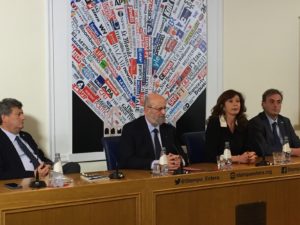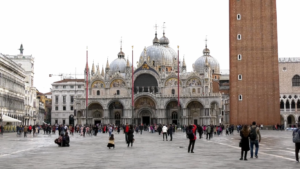There seems to be differences of opinion about when and to whom the well-traveled American journalist/humorist Robert Benchley sent his telegram on his first visit to Venice: “Streets full of water. Please Advise.” The most credible attribution is that it was a gag sent to his editor Harold Ross at The New Yorker. Last month on November 12, many journalists and visitors to La Serenissima unwittingly sent overly dramatic messages and photographs on Twitter, WhatsApp or Instagram, except that they weren’t meant as a joke.
That evening from c. 8 PM to 2 AM the next morning, its peak being at c. 11 PM, the acqua alta (high water), which has happened on occasion for centuries, had reached a high of 1.87 meters (recently superseded only in 1966 at 1.94) and the news, although not fake, but certainly misleading, flashed around the world. The rule of thumb in journalism, “a picture is worth a thousand words”, caused a double whammy: unnecessary panic and some 45% of near-future visitors to cancel their bookings through March. I remember well how the Mafia’s bomb in 1993 near the Uffizi in Florence caused a similar domino effect of cancelled vacations to Italy including some by members of my own well-traveled family, who should have known better.
So, if you are one of the panic-stricken cancelers or have erased Venice from your “wish-list”, please read on. In an attempt to “calm the waters”, set the record straight, and bring us up to date after a month, on December 19, hotelier Vittorio Bonacini, the President of the Associazione Veneziana Albergatori (The Venetian Association of Hoteliers), its Director Claudio Scarpa, and its two vice-Presidents Daniele Minotto and hotelier Stefania Stea, owner of the luxurious Ca’ Nigra Lagoon Resort on the Grand Canal, came to the Associazione della Stampa Estera in Italia (The Foreign Press Association) to explain what had really happened and why tourists don’t need to be afraid to visit Venice.

Scarpa, Bonacini, Stea and Minotto at Stampa Estera (courtesy of AVA)
Bonacini, the owner of Hotel Tintoretto, said that: “Venice’s 274 hotels (400, if you include Mestre and other mainland environs too), 75% of which belong to AVA, are usually sold-out at New Years through Epiphany, but this year our bookings are less than 50%. We have been hardest hit by American cancellations because 15% of Venice’s some 11 million overnight tourists every year are Americans, followed by the British at 8% and the French at 7%. Nothing like this has ever happened before, not even after September 11.”
He went on to explain that contrary to the impression created by the media’s sensationalist representations, November 12’s acqua alta was a freak event. “Acqua alta can take place in the fall or winter and is caused by the lagoon’s tides of six-hour cycles,” he said. “Only this time, on November 12, the high tide was much higher than usual due to the full moon and the axis of the earth. The lagoon was “gonfia” or swollen due to lower than usual barometric pressure and cross winds from both the north and the south causing a kind of cyclone. The sirocco, a hot wind blowing from Africa, pushed the lagoon’s water towards the coast and therefore Venice at some 126 kilometers per hour. Such speed was traumatic, but, since acqua alta is tidal, it grows and then recedes.”

Piazza San Marco on November 15 (courtesy of AVA)
He also emphasized how the press, particularly its photographs of St. Mark’s Square “underwater”, had exaggerated the phenomenon and its danger. “Reporting that the acqua alta measured 1.87 meters was misleading to the general public, if not irresponsible. If that had really been the height of the acqua alta, we would have all drowned. In actual fact the 1.87 is not measured from the pavement of St. Mark’s Square, but from a “point 0 tide gauge” at the Punta della Salute. What most people don’t realize, “ Bonacini underscored, is that some 97% of Venice is about a meter higher than sea level. Therefore, for example, if a high tide measures 1.40 meters, which is very unusual, it means that in the lowest areas of the city, which includes St. Mark’s Square, the water level can reach 60 centimeters or some twenty inches, and floods about half the city. That night no one was or now is in danger of drowning which has been the most frequent question our members have been asked since November 12, ie. “If I come with my five-year-old, will he or she be underwater? One of our future guests wanted to know if there would be acqua alta when he comes in May and if restaurants and museums would be open. We assured him that they’d never closed.”
Bonacini did admit, however, that, although November !2th’s acqua alta was in no way life-threatening, it did cause considerable damage. Our Mayor Luigi Brugnaro declared a state of emergency and estimated damages of 1 billion euros. AVA’s hotels estimate 30 million euros in damages not including lost bookings, and the Ministry of Culture at least 6 million euros to works-of-art.”
Well before the press conference I had already read that luckily the Accademia, the Ducal Palace, and Correr Museum were spared. The hardest hit were the floors of St. Mark’s Cathedral where the crypt flooded and some of the pavements’ mosaic tesserae were washed away. About half of the city’s other monumental churches especially San Moisè and the Scuola di San Giorgio degli Schiavoni, the Ca’ Pesaro museum , the art library of the Fondazione Querini Stampalia, and scores by Vivaldi and Cimarosa at the Benedetto Marcello Conservatory, not to mention the damage to many glass and carnival mask artisans, who lost their stock, and to a number of private citizens, who lost their domestic appliances among other valuables. In the churches the salt of the water has penetrated and started to corrode their marble columns.
Bonacini appealed to us journalists to reassure our readers that within six hours of this freakish acqua alta the city, which had remained completely safe, was up and running as always, even the vaporetti, though some of those had been damaged. “Many of the restaurants and bars had even stayed open in spite of the weather,” he repeated, “not to mention, there is no need to pack goulashes since AVA’s member hotels always provide their guests with high rubber boots during all episodes of acqua alta”. He ended on an upbeat note by saying that a recent guest at his hotel had been disappointed not to see Venice during acqua alta and was going to plan his next trip accordingly.
Speaking for myself, in the some fifty years I have lived in Italy with at least one trip to my beloved Serenissima every year and often in the fall and winter I too have never seen acqua alta. So don’t cancel your trip to this unique and magical patrimony of humanity. If you do, the damage to Venice will be much more than the water’s. Not only Bonacini and his fellow-hoteliers will suffer, but thousands of other businesses and jobs connected to tourism will be endangered or lost: hotel employees, restaurateurs, their chefs and waiters, bars, artisans, shopkeepers, tourist guides, and gondoliers to name only a few.

It just goes to show one shouldn’t jump to conclusions.